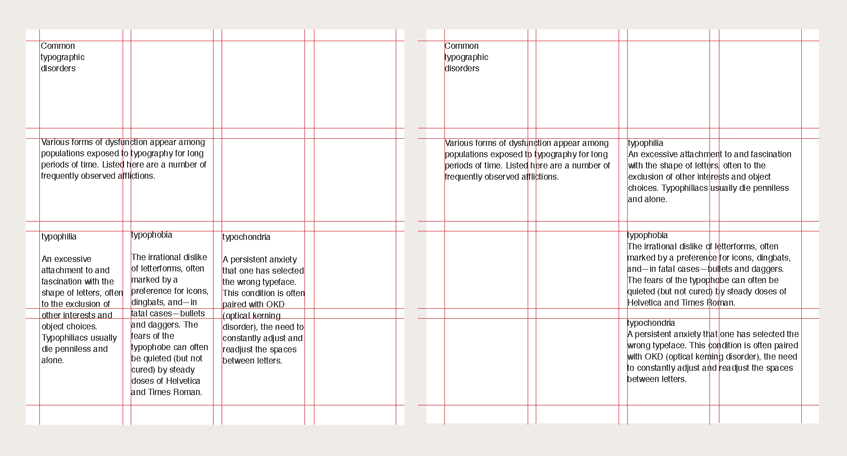Table Of Content

To help us make the most of our work surfaces and create with precision, we designers have a tool that echoes this. Baselines, on the other hand, are horizontal lines that align the bottoms of text elements. They create a sense of order and consistency, making your design look polished and professional. By aligning text elements to a baseline grid, you ensure that everything is visually aligned and easy to read.
Texas city adopts street grid and code - Congress for the New Urbanism
Texas city adopts street grid and code.
Posted: Fri, 15 Nov 2019 08:00:00 GMT [source]
Defining the Grid Container:
The family needed a set of compact chairs that could fit neatly under the dining table. The Brno chair was designed for this purpose with a low sweep of the arms and compact form to fit neatly under the table. The aim is to provide a snapshot of some of themost exciting work published in the various research areas of the journal. The Design Guidelines as provided herein are for the use of TDOT and their consultants. The Design Guidelines are in Adobe Acrobat Portable Document Format (PDF).
#153: Getting Started with CSS Grid
Consider this the next time you use pull-quotes or if you’re embedding an image within your column. In the article Thinking Outside the Grid Molly E. Holzschlag discusses concepts of creating compelling visual design that breaks the mold of the grid. This is an inspiring conceptual article that also discusses the complexities involved in coding designs that are less rigid. Its important to know your tools before trying to get creative with them. This means you should study the grid and understand how to successfully use it to create your site layouts. Learn to achieve balance, symmetry, and place emphasis on important content all through the use of the grid.
Advanced Figma Tips for UX/UI Designers
CSS Grid provides many options for defining grid our columns. Using fr units to create a symmetrical grid is only one option of many. At the end of this post, we also answered the 3 most common questions about grid layouts.
Illustrations and the use of design elements allow for overlapping and breaking out of the structure you’ve created in your grid. They can be used to add some areas of creative disorder to counterbalance the rigidity of the grid. A grid is the division of a layout with vertical and/or horizontal guidelines to incorporate margins, spaces and columns in order to provide a framework for organizing content.
Responsive Grid

To maintain a visually cohesive and harmonious layout, aligning the sizes of icons, buttons, and other UI elements with the 8-point grid system is crucial. Ensuring their dimensions correspond to the multiples of 8 fosters visual harmony and balance. This technique creates a unified visual language and provides an intuitive and polished user experience. Block grids can also be referred to as single-column grids or manuscript grids, and are considered to be the simplest grid structure.
These insights will help you to achieve the best possible user experience. The simplest grid consists of a single column of text surrounded by margins. Essentially, every time you open a new document in a page layout program, you are prompted to create a single column grid.
As many columns as will fit
We will create a 12 column grid — a very common choice that is seen to be very adaptable to different situations given that 12 is nicely divisible by 6, 4, 3, and 2. A grid will typically have columns, rows, and then gaps between each row and column — commonly referred to as gutters. There is a big chance that you, as a web designer, used some type of grid-based layout for your page, but you didn’t realize it. Margins are the negative space between the outer edge of the content on your page and the format. They vary a lot, especially between desktop and mobile devices.
Grid for layout, flexbox for components
The result is nine equal parts of the page, formed by lines intersection. They represent vertical sections that span the height of the content area. In this overview, we've toured the main features of CSS Grid Layout. To dig further into the specification, read our guides on Grid Layout, which can be found below. We now move on from creating a grid to placing things on the grid. Our grid always has lines — these are numbered beginning with 1 and relate to the writing mode of the document.
An alternative way to arrange items on your grid is to use the grid-template-areas property and give the various elements of your design a name. To see something that looks more grid-like, we'll need to add some columns to the grid. You can use any length unit or percentage to create these column tracks.
Now that you have a document with a grid, do something useful with it and create columns and gutters. Columns are the groupings of grid units that create the visual structure of the page. Guides are without a doubt the most convenient way to establish the boundaries of columns and gutters. Adopting the 8-point grid system creates a harmonious and visually pleasing design, especially when working with multiple screen sizes and responsive layouts. To fully understand grids and layouts in UI design, you must familiarize yourself with the foundational elements. Essential grid elements are margins, columns, rows, and gutters.


No comments:
Post a Comment